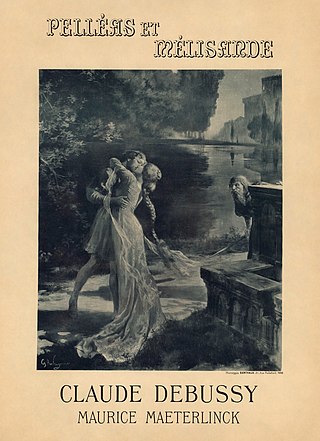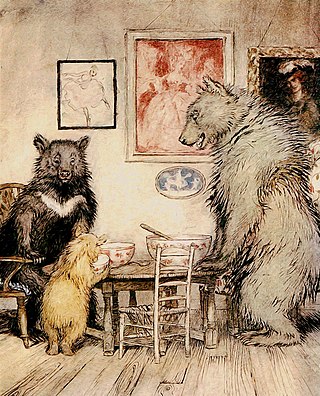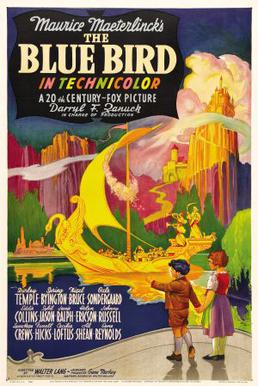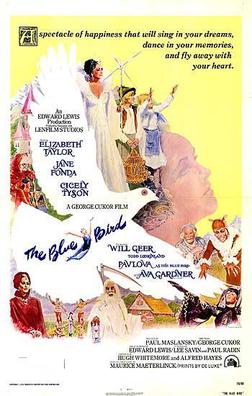

L'oiseau bleu (The Blue Bird) is an opera in four acts (eight tableaux) by the French composer and conductor Albert Wolff. The libretto by Maurice Maeterlinck is based on his 1908 play of the same name. Boris Anisfeld designed the sets.


L'oiseau bleu (The Blue Bird) is an opera in four acts (eight tableaux) by the French composer and conductor Albert Wolff. The libretto by Maurice Maeterlinck is based on his 1908 play of the same name. Boris Anisfeld designed the sets.
It was first performed at the Metropolitan Opera House, New York City on 27 December 1919. [1]
Maeterlinck, the playwright and Nobel laureate, was present at the premiere, which, in the immediate aftermath of World War I, was a benefit for four charities: the Queen of the Belgians Fund, the Millerand Fund for French Orphans, the Three Big Sister Organizations (Catholic, Protestant, Jewish), and the Milk for the Children of America Fund. [2]
The first Belgian performance was on 21 April 1920, [3] and it was revived at the Théâtre de la Monnaie on 14 February 1956, conducted by the composer. [4]
| Role | Voice type | Premiere cast, 27 December 1919 Conductor: Albert Wolff |
|---|---|---|
| Tyltyl | mezzo-soprano | Raymonde Delaunois |
| Mytyl | soprano | Mary Ellis |
| Mother Tyl | soprano | Florence Easton |
| Father Tyl | baritone | Paolo Ananian |
| Grandmother Tyl | mezzo-soprano | Louise Berat |
| Grandfather Tyl | bass | Léon Rothier |
| Maternal Love | soprano | Florence Easton |
| Joy of Understanding | soprano | Gladys Axman |
| Light | mezzo-soprano | Flora Perini |
| Father Time | bass | Leon Rothier |
| Bread | baritone | Mario Laurenti |
| Milk | soprano | Marie Tiffany |
| The little girl | soprano | Edna Kellogg |
| Two little lovers | mezzo-soprano, contralto | Minnie Egener, Helena Marsh |
| Joy of Being Just | - | Margaret Farnham |
| Joy of Seeing What is Beautiful | mezzo-soprano | Cecil Arden |
| The fairy | contralto | Jeanne Gordon |
| Night | mezzo-soprano | Frances Ingram |
| The cat | soprano | Margaret Romaine |
| The dog | - | Robert Cousinou |
| Mme Berlingot | contralto | Jeanne Gordon |
| Happiness | soprano | Mary Mellish |
| The child | - | Ada Vosari |
| Sugar | tenor | Octave Dua |
| Fire | tenor | Angelo Badà |
| Another child | - | Miss Kennedy |
| First child | - | Miss Belleri |
| Second child | - | Miss Florence |
| Third child | - | Miss Borniggia |
| Fourth child | soprano | Phyllis White |
| Fifth child | - | Miss Manetti |
Tyltyl and Mytyl are the children of a poor wood-chopper. At Christmas there is no tree or Christmas stocking for them. When the parents believe them safely tucked up in bed, the children creep out and watch through the window the preparations being made for the holiday in a wealthy neighbour’s home across the way.
While they are absorbed in this, Fairy Berylune enters. She is a witch who demands from the children that they bring her the grass that sings, and the bird that is blue so that her own little child who is sick may be restored to health and happiness. Upon agreeing to find the bird, the fairy crowns Tyltyl with a magic cap set with a wonderful diamond, which has power to disclose the past and future, and to turn inanimate objects and animals into speaking creatures. Everything around the children begins to take life and voice: milk, sugar, light, bread, the fire, cat and dog.
Suddenly the window opens and the children set off on their quest. They go first to the Land of Memory, then the Palace of the Night, Garden of Happiness, the Cemetery and then the Kingdom of the Future, but cannot capture the blue bird. They return home to bed.
When morning comes, a neighbour who looks like the Fairy enters to beg for a blue bird so that her sick child may be cured by the sight of it. Looking around, the children are amazed to see that their own turtle dove has turned blue. They gladly offer it for the sick child, and with the gift the invalid’s spirits return. When Tyltyl asks for its return and the child shows reluctance to give it back, the blue bird escapes from both and flies off.
The Blue Bird may refer to:

Maurice Polydore Marie Bernard Maeterlinck, also known as CountMaeterlinck from 1932, was a Belgian playwright, poet, and essayist who was Flemish but wrote in French. He was awarded the Nobel Prize in Literature in 1911 "in appreciation of his many-sided literary activities, and especially of his dramatic works, which are distinguished by a wealth of imagination and by a poetic fancy, which reveals, sometimes in the guise of a fairy tale, a deep inspiration, while in a mysterious way they appeal to the readers' own feelings and stimulate their imaginations". The main themes in his work are death and the meaning of life. He was a leading member of La Jeune Belgique group and his plays form an important part of the Symbolist movement. In later life, Maeterlinck faced credible accusations of plagiarism.

Pelléas et Mélisande is an opera in five acts with music by Claude Debussy. The French libretto was adapted from Maurice Maeterlinck's symbolist play of the same name. It premiered at the Salle Favart in Paris by the Opéra-Comique on 30 April 1902; Jean Périer was Pelléas and Mary Garden was Mélisande, conducted by André Messager, who was instrumental in getting the Opéra-Comique to stage the work. The only opera Debussy ever completed, it is considered a landmark in 20th-century music.

A changeling, also historically referred to as an auf or oaf, is a human-like creature found in folklore throughout Europe. A changeling was believed to be a fairy that had been left in place of a human stolen by other fairies.

The Blue Bird is a 1908 play by Belgian playwright and poet Maurice Maeterlinck. It premiered on 30 September 1908 at Konstantin Stanislavski's Moscow Art Theatre, and was presented on Broadway in 1910. The play has been adapted for several films and a TV series. The French composer Albert Wolff wrote an opera based on Maeterlinck's original play, and Maeterlinck's inamorata Georgette Leblanc produced a novelization.

"Goldilocks and the Three Bears" is a 19th-century English fairy tale of which three versions exist. The original version of the tale tells of an obscene old woman who enters the forest home of three anthropomorphic bachelor bears while they are away. She eats some of their porridge, sits down on one of their chairs and breaks it, and sleeps in one of their beds. When the bears return and discover her, she wakes up, jumps out of the window, and is never seen again. The second version replaces the old woman with a young girl named Goldilocks, and the third and by far best-known version replaces the bachelor trio with a family of three.

The Blue Bird is a 1918 American silent fantasy film based upon the 1908 play by Maurice Maeterlinck and directed by Maurice Tourneur in the United States, under the auspices of producer Adolph Zukor. In 2004, this film was deemed "culturally, historically, or aesthetically significant" by the United States Library of Congress and selected for preservation in its National Film Registry.

The Blue Bird is a 1940 American fantasy film directed by Walter Lang. The screenplay by Walter Bullock was adapted from the 1908 play of the same name by Maurice Maeterlinck. Intended as 20th Century Fox's answer to MGM's The Wizard of Oz, which had been released the previous year, it was filmed in Technicolor and tells the story of a disagreeable young girl and her search for happiness.

The Blue Bird is a 1976 American-Soviet children's fantasy film directed by George Cukor. The screenplay by Hugh Whitemore, Alfred Hayes, and Aleksei Kapler is based on the 1908 play L'Oiseau bleu by Maurice Maeterlinck. It was the fifth screen adaptation of the play, following two silent films, the studio's 1940 version starring Shirley Temple, and a 1970 animated feature. It was famous as one of the few cinematic co-productions between the United States and the Soviet Union during the Cold War. However unlike prior adaptations the film received little-to-no critical praise and was a flop at the box office.
The Blue Bird is a 1970 Soviet animated feature film based upon the 1908 play by Maurice Maeterlinck. It was directed by Vasily Livanov and made at the Soyuzmultfilm studio.

Maeterlinck's Blue Bird: Tyltyl and Mytyl's Adventurous Journey is a 1980 Japanese animated television series directed by Hiroshi Sasagawa, with character designs from Leiji Matsumoto. It is based on the 1908 play by Maurice Maeterlinck. The series was 26-episodes long when aired on Japanese television. The series was made in Japan between 1978 and 1979.

The symbol of a bluebird as the harbinger of happiness is found in many cultures and may date back thousands of years.

Lovely♡Cat's Eye (ラブリー♡キャッツアイ) is the fourth single by Japanese singer-songwriter misono. The single peaked at No. 9 on the Oricon charts, but dropped in rank to take the No. 15 slot.

Georgette Leblanc was a French operatic soprano, actress, author, and the sister of novelist Maurice Leblanc. She became particularly associated with the works of Jules Massenet and was an admired interpreter of the title role in Bizet's Carmen.

Raymonde Delaunois was a Belgian mezzo-soprano opera singer.
Pauline Fossil is a fictional character from the 1936 children's book Ballet Shoes by Noel Streatfeild. In the 2007 film adaption she is played by Emma Watson, and in the 1975 TV serial she is played by Elizabeth Morgan.

Frederick Cayley Robinson was an English artist who created paintings and applied art, including book illustrations and theatre set designs. Cayley Robinson continued to paint striking Pre-Raphaelite and Victorian subjects well into the twentieth century despite this approach becoming deeply unfashionable.

L'Oiseau bleu is a large oil painting created in 1912–1913 by the French artist and theorist Jean Metzinger (1883–1956); considered by Guillaume Apollinaire and André Salmon as a founder of Cubism, along with Georges Braque and Pablo Picasso. L'Oiseau bleu, one of Metzinger's most recognizable and frequently referenced works, was first exhibited in Paris at the Salon des Indépendants in the spring of 1913, several months after the publication of the first Cubist manifesto, Du "Cubisme", written by Jean Metzinger and Albert Gleizes (1912). It was subsequently exhibited at the 1913 Erster Deutscher Herbstsalon in Berlin.
L'oiseau bleu is French for "The Blue Bird".

Renée Dahon (1893–1969) was a French actress.